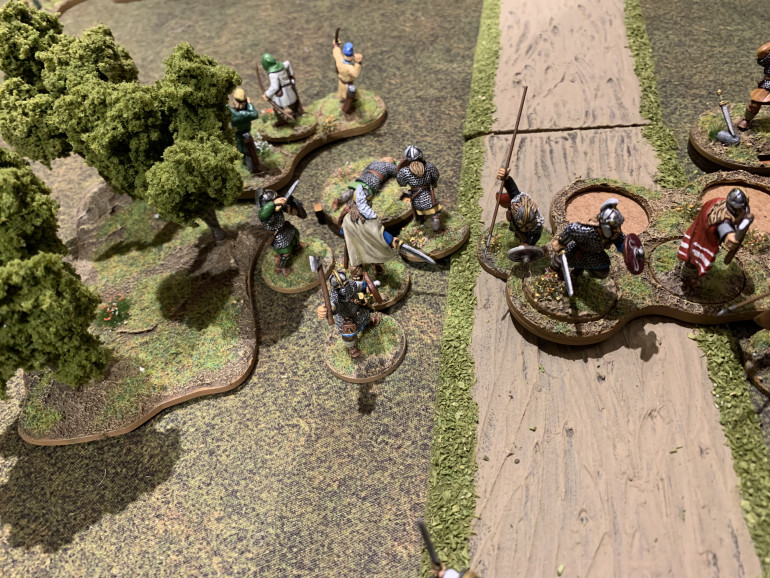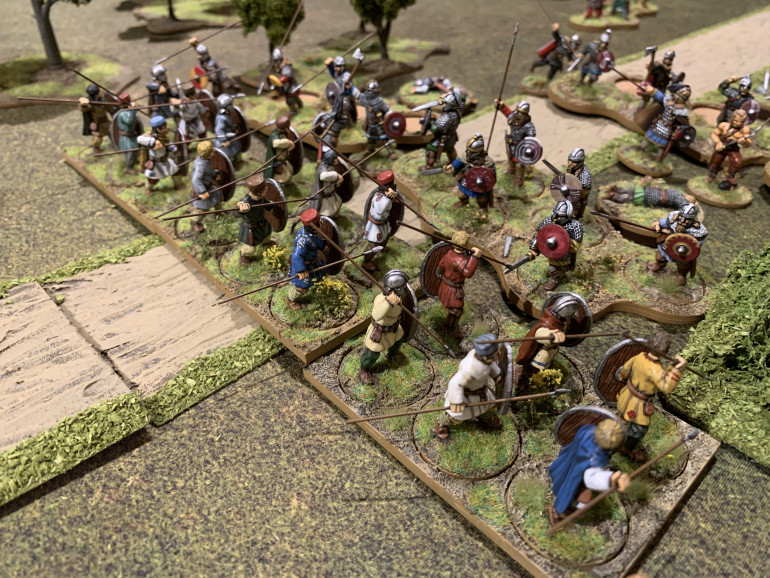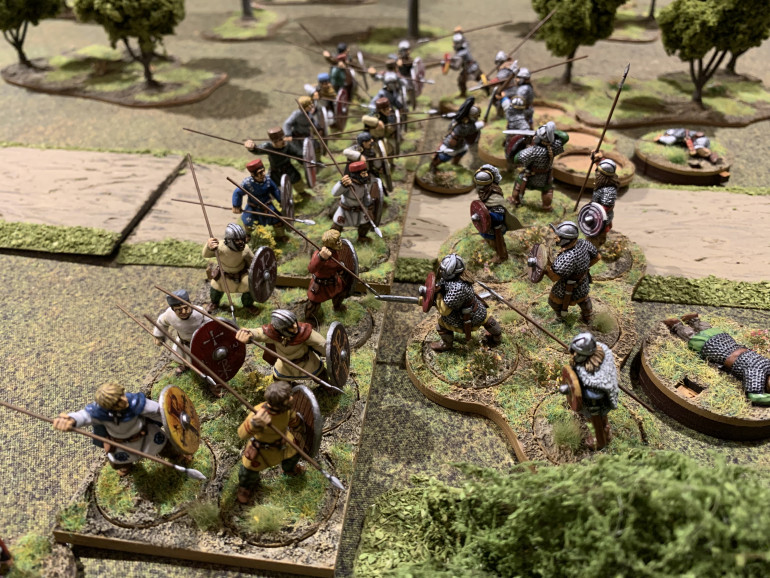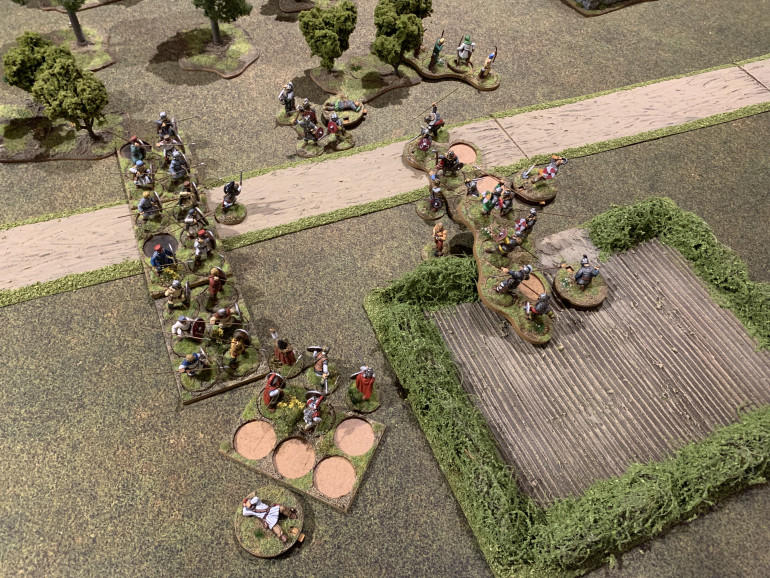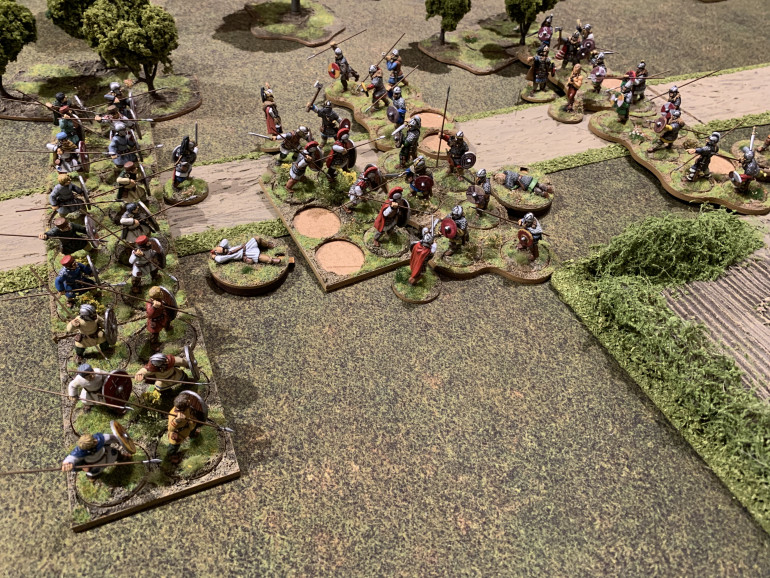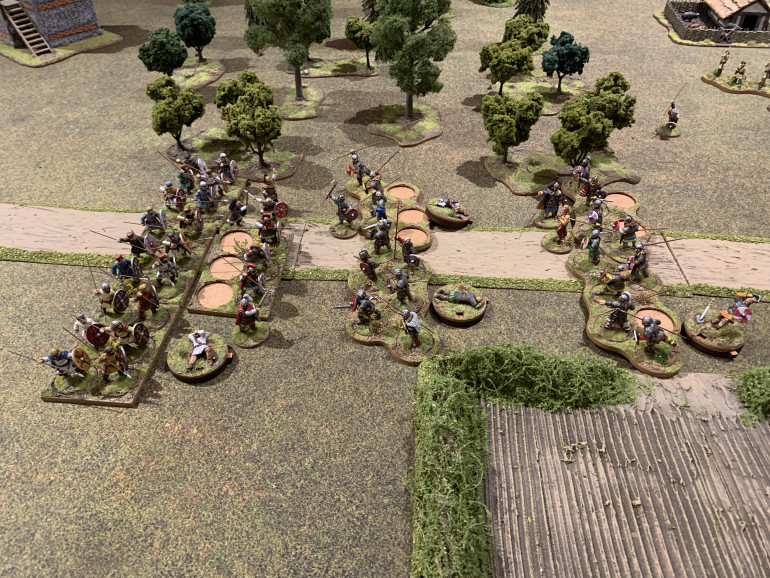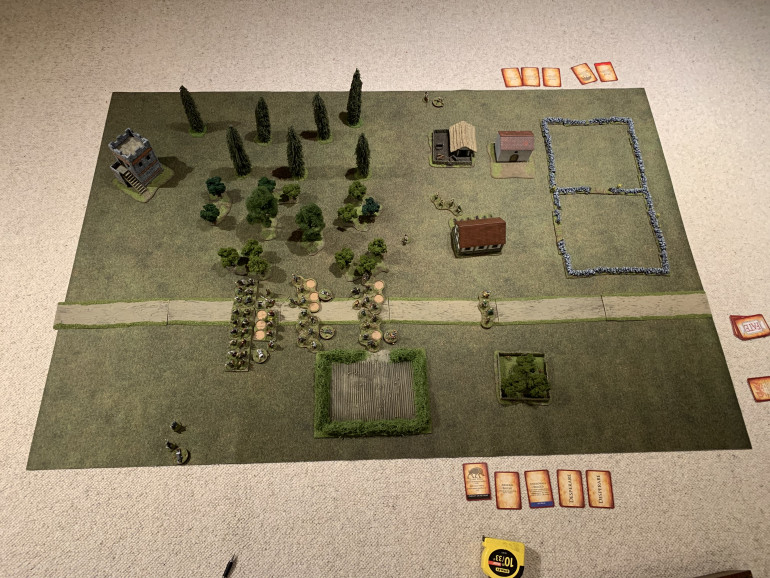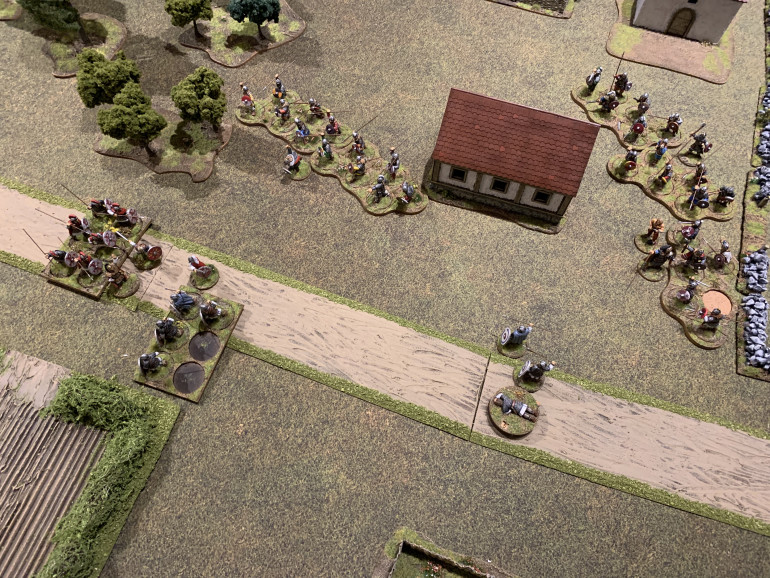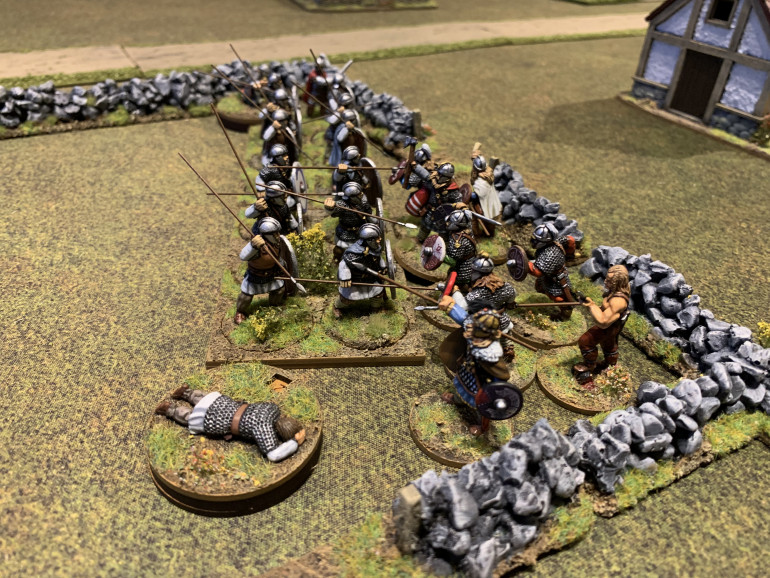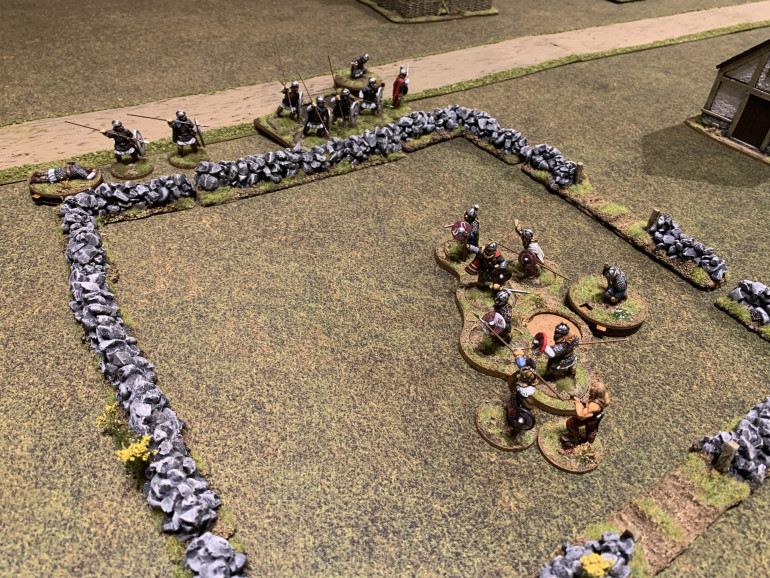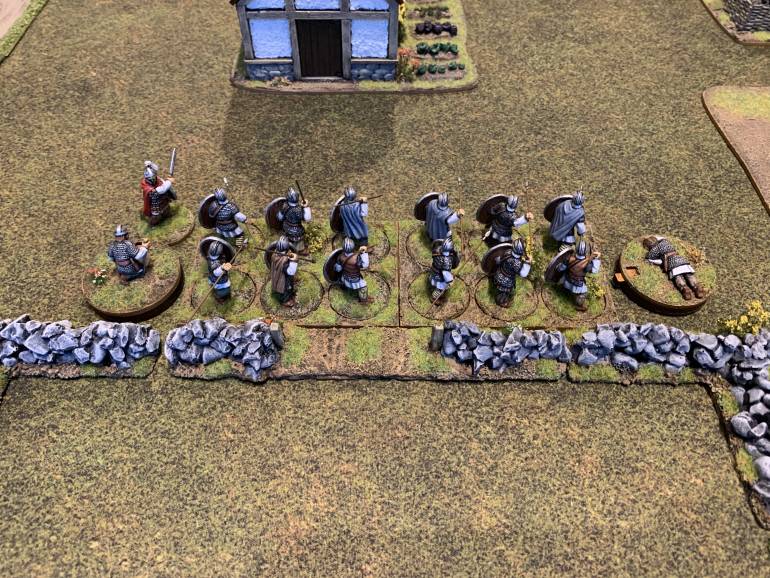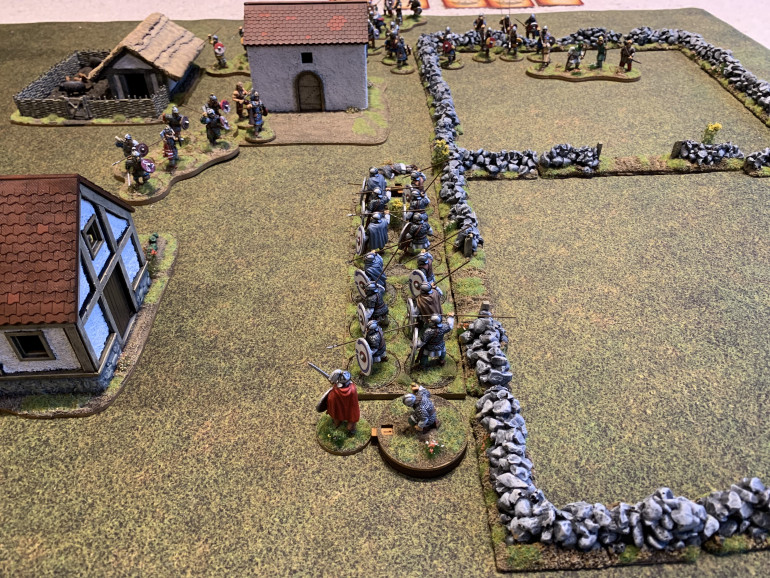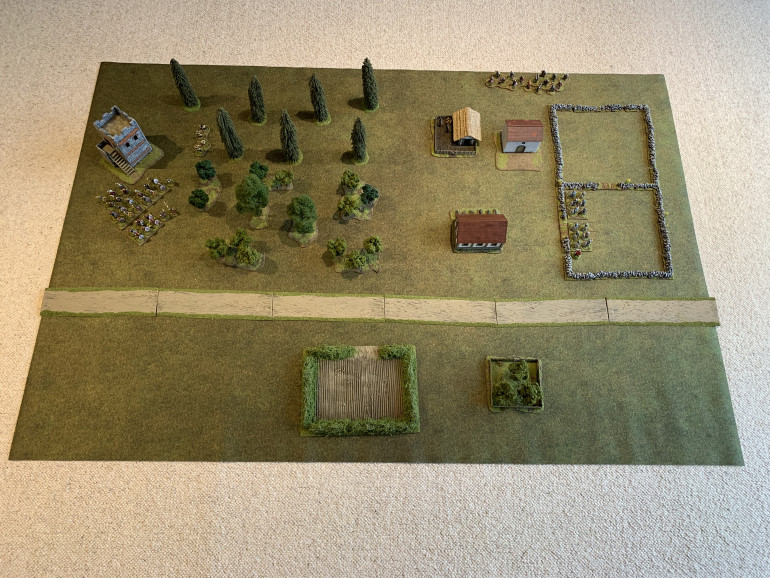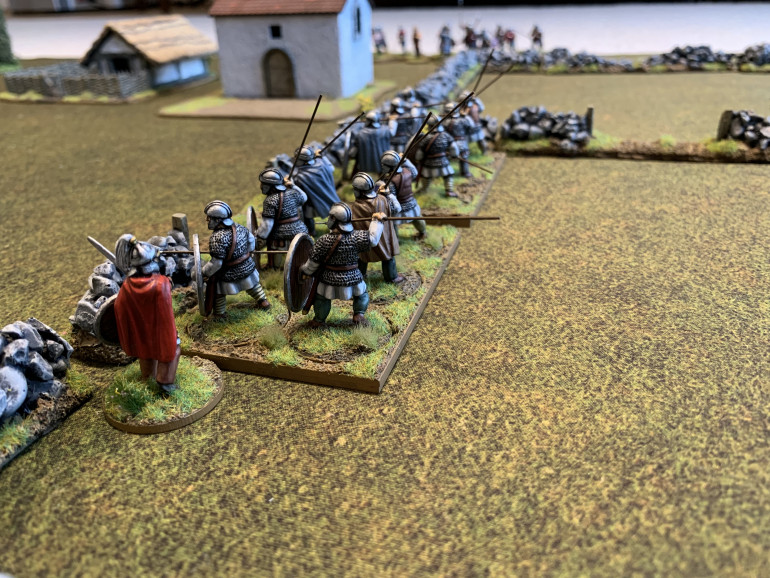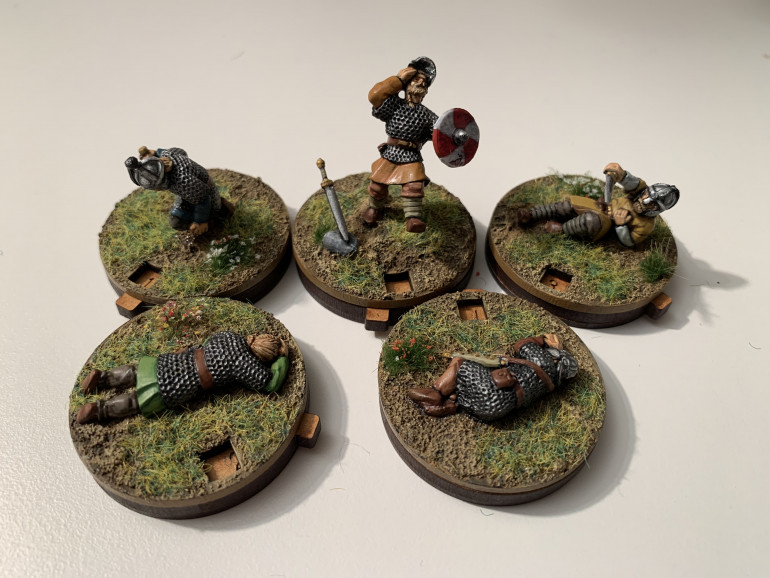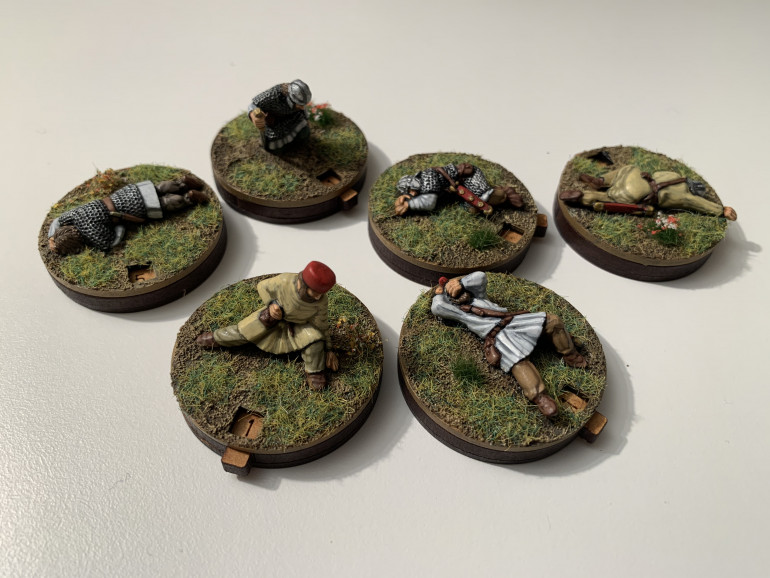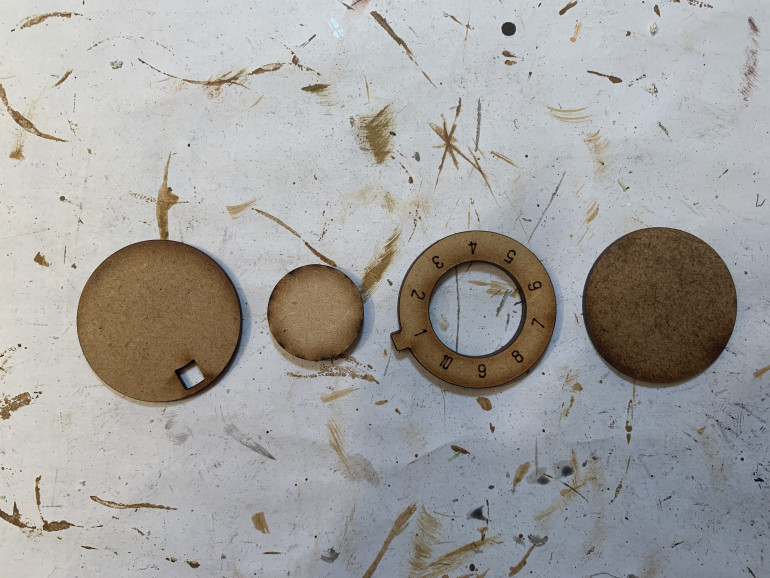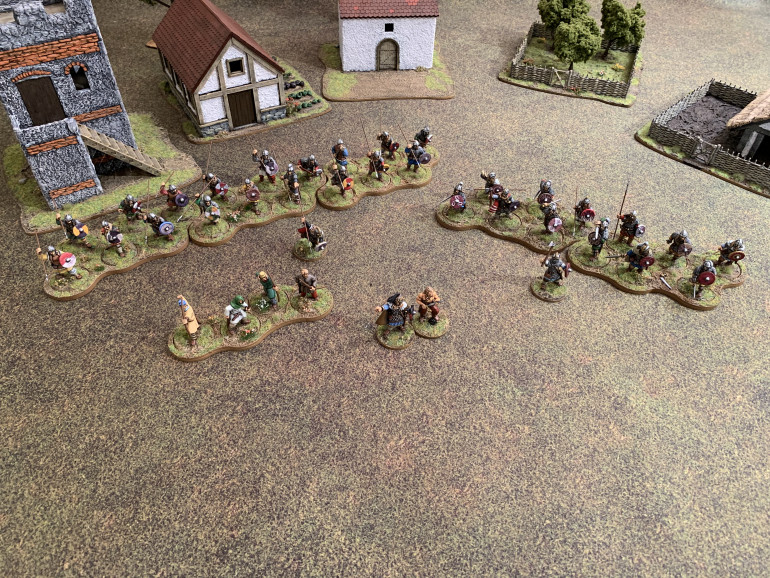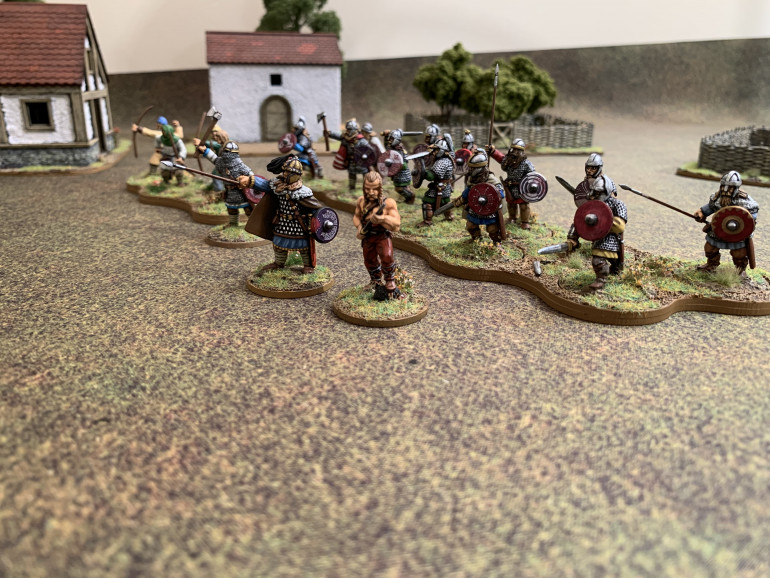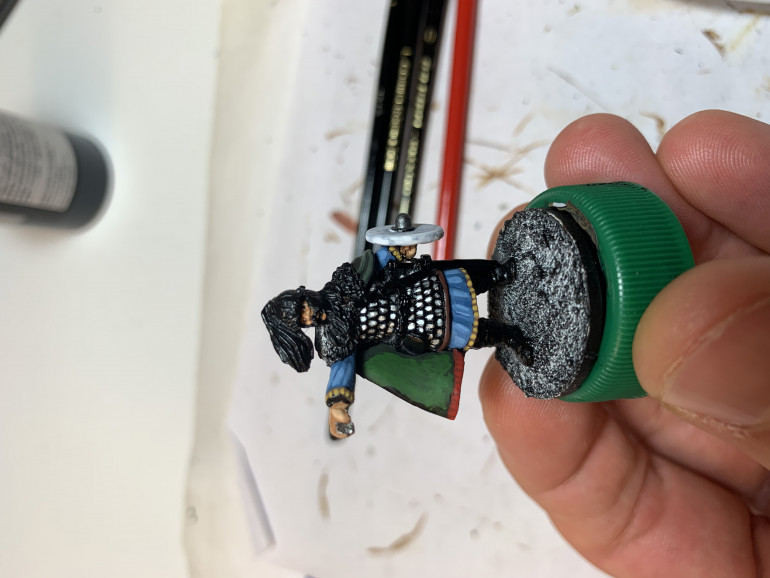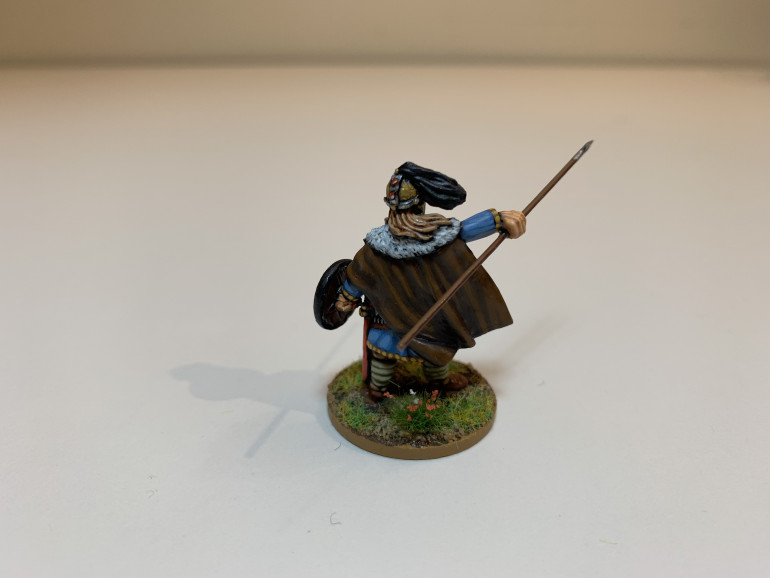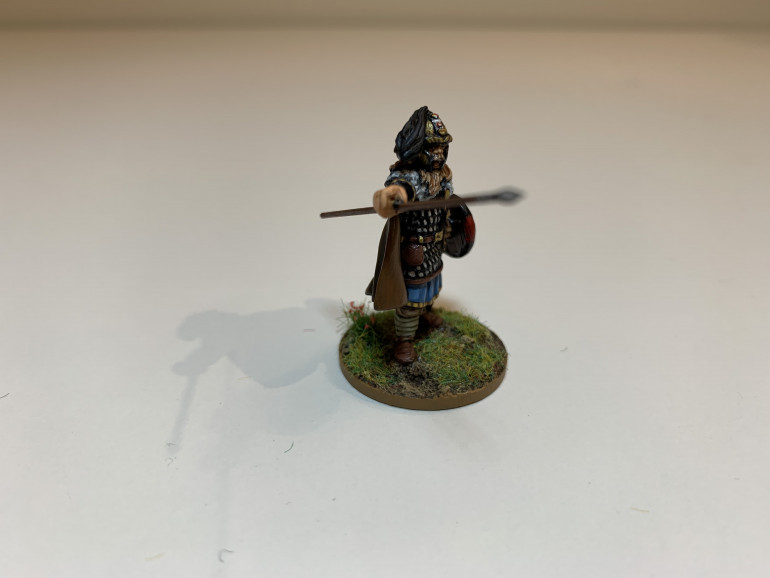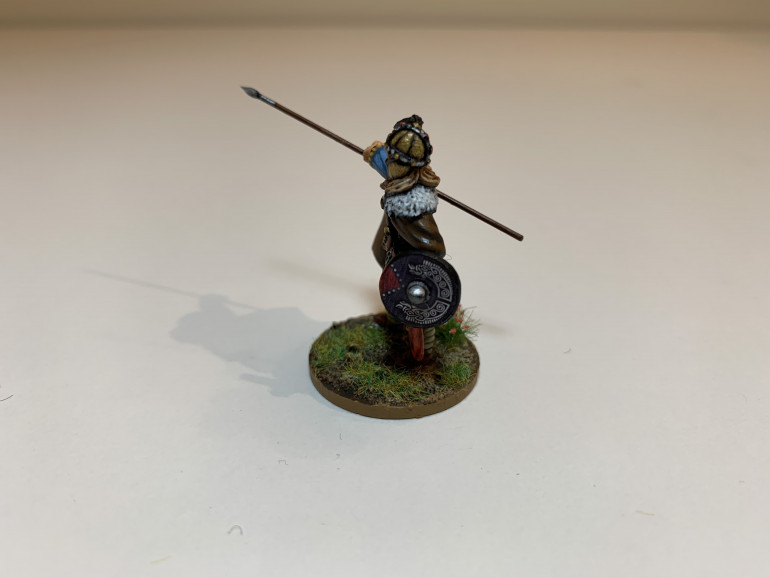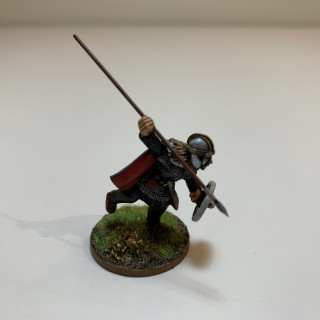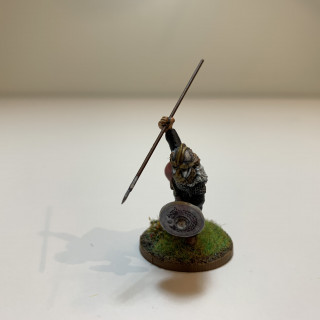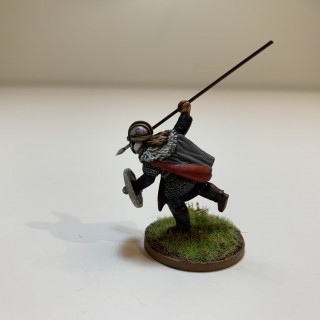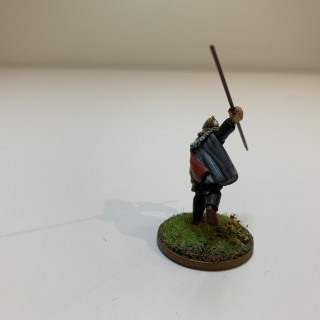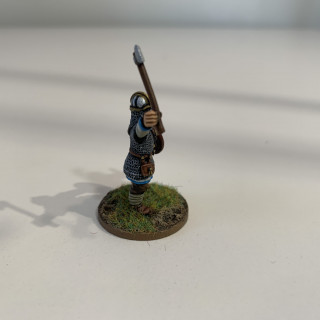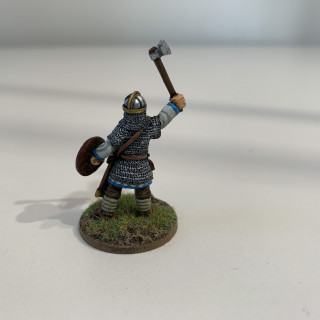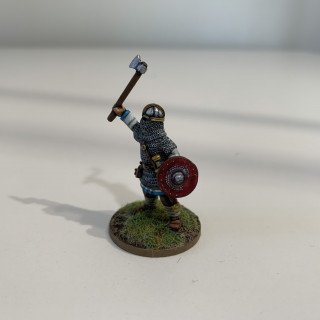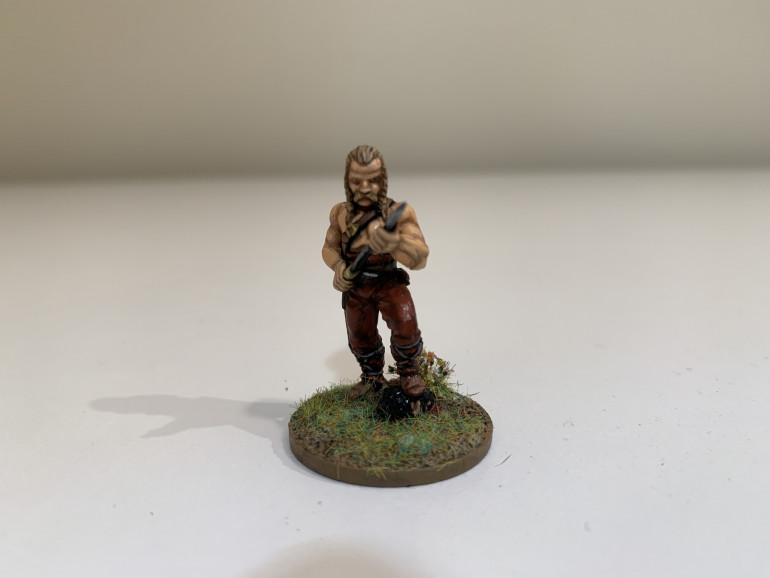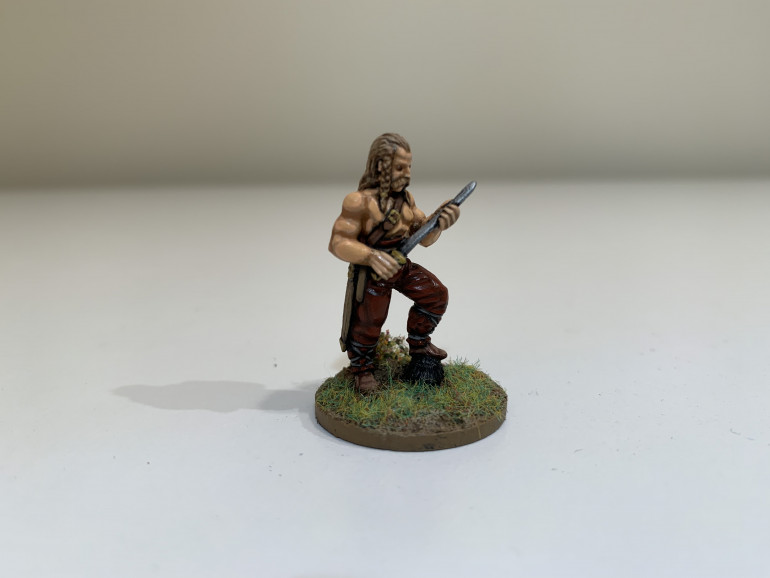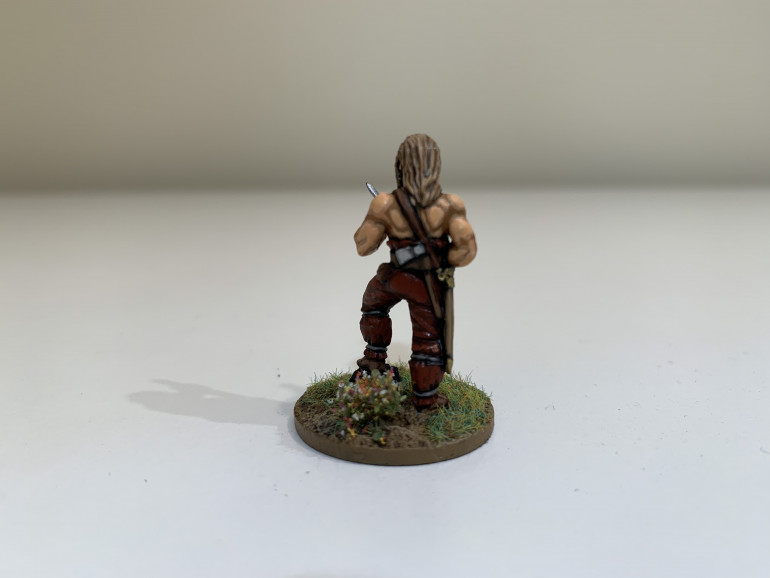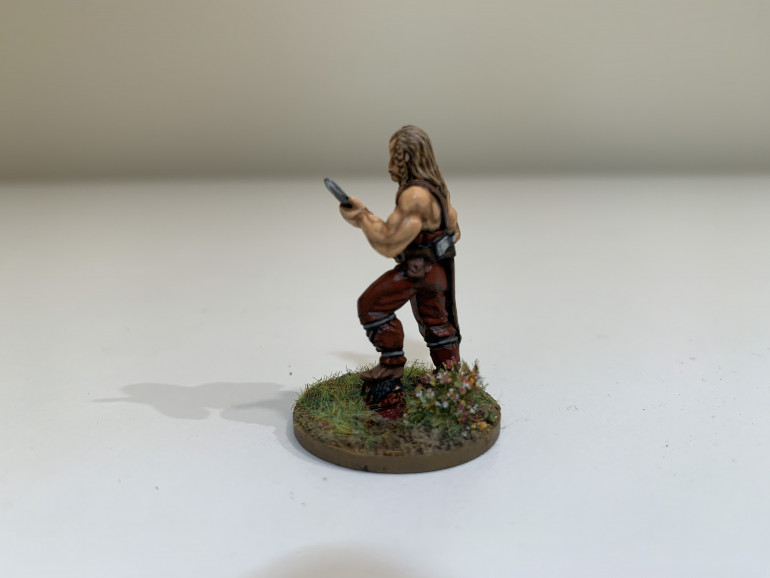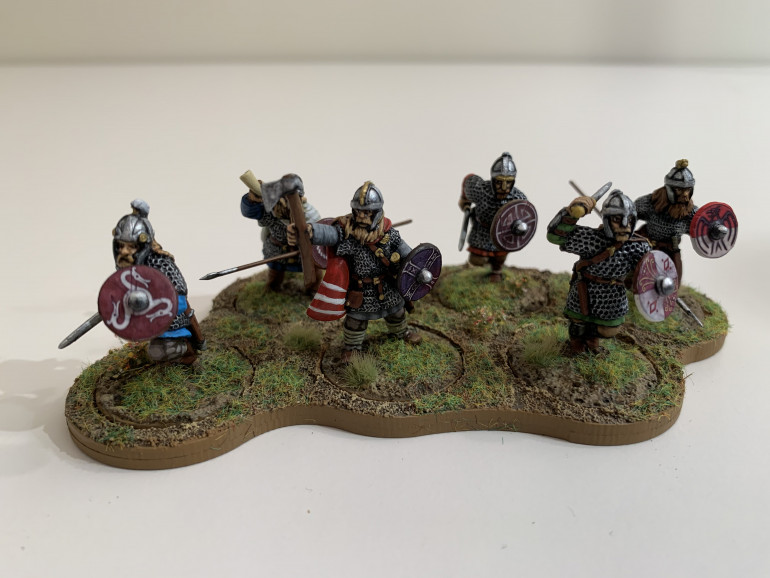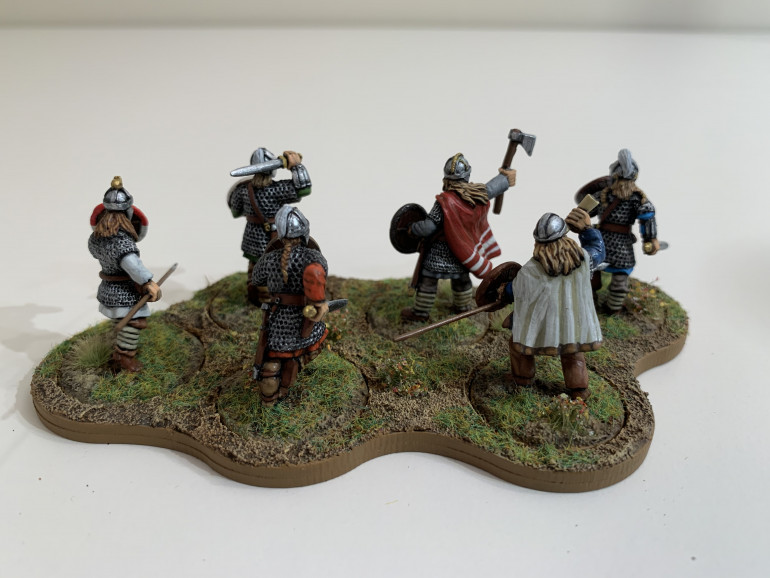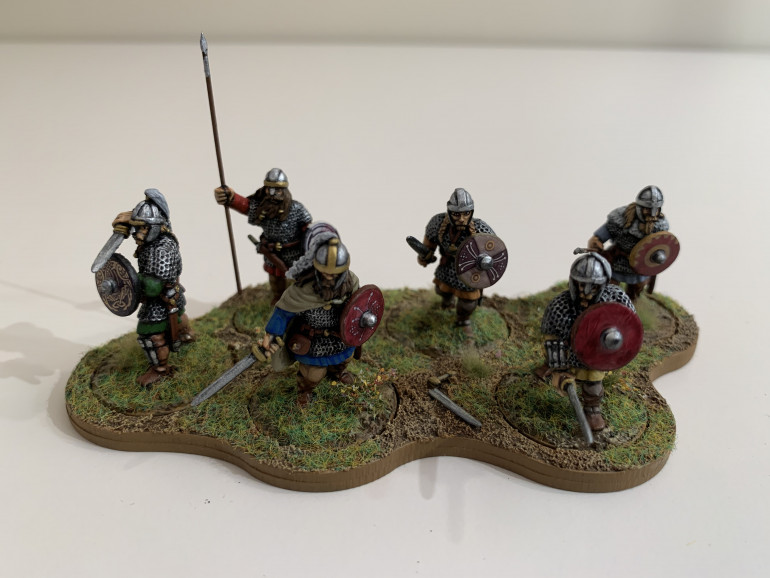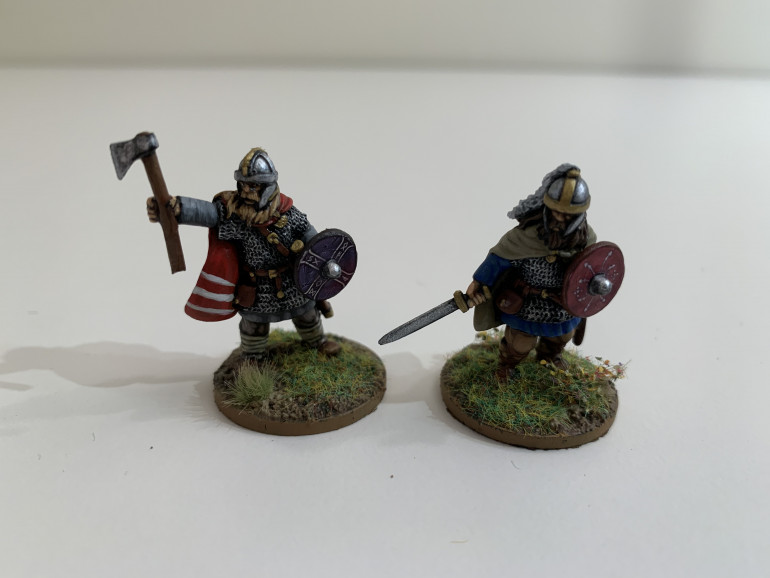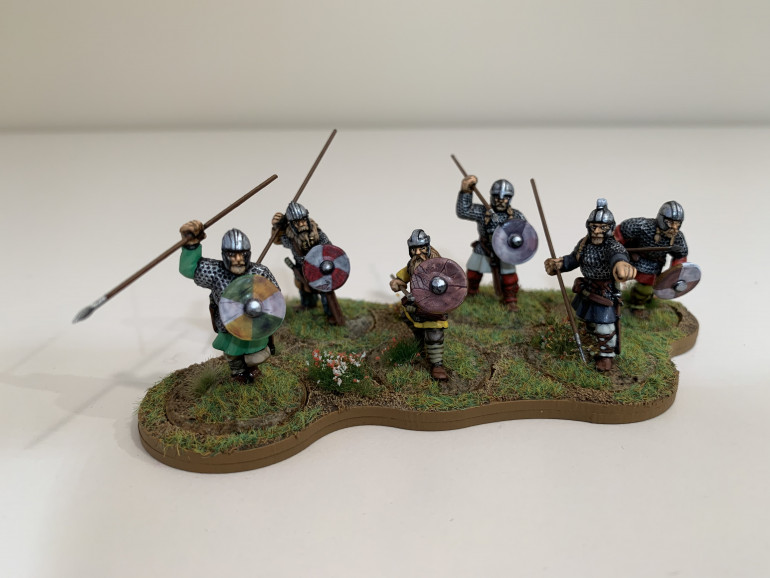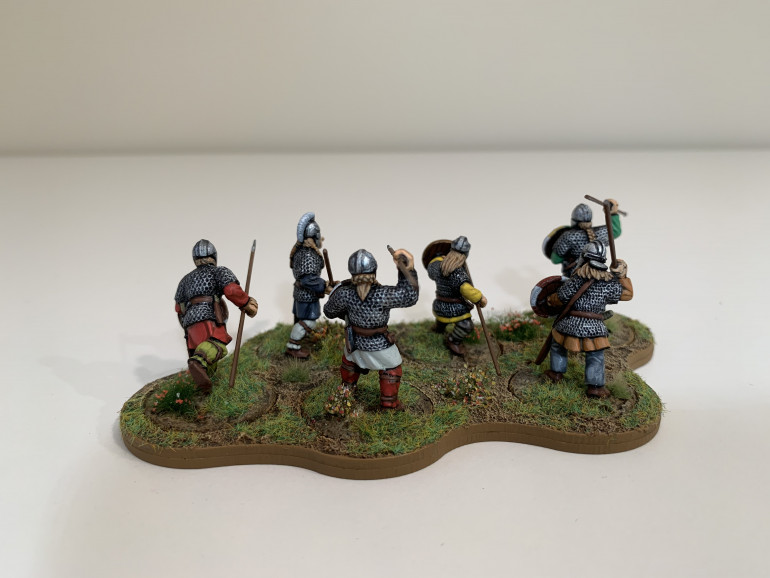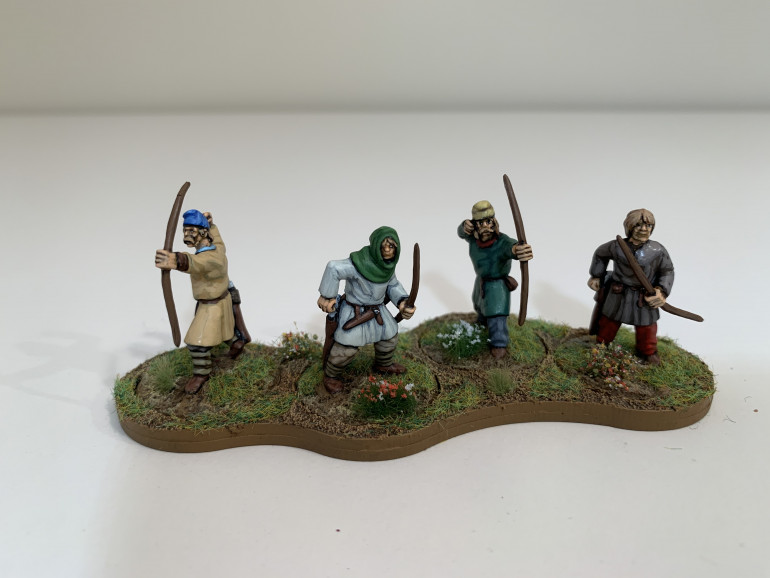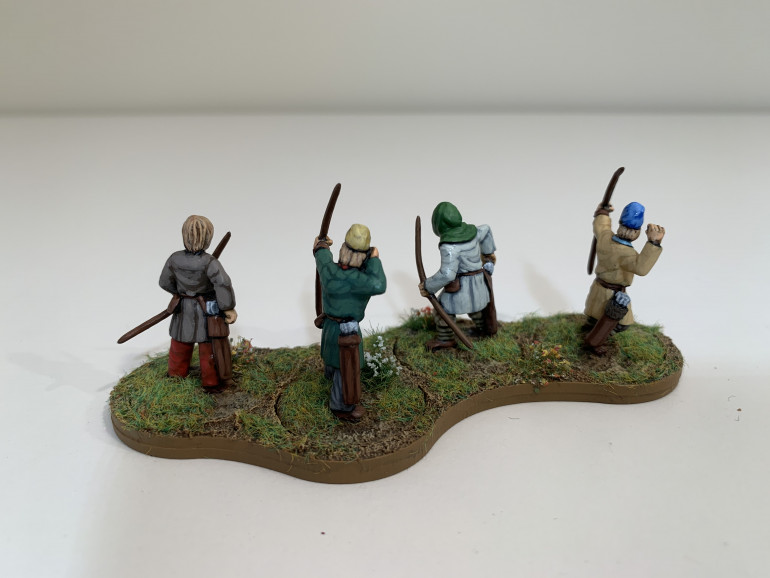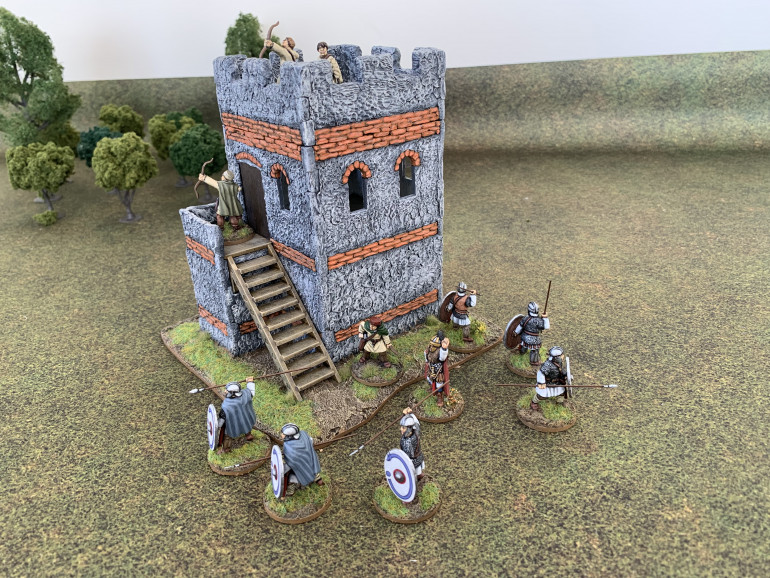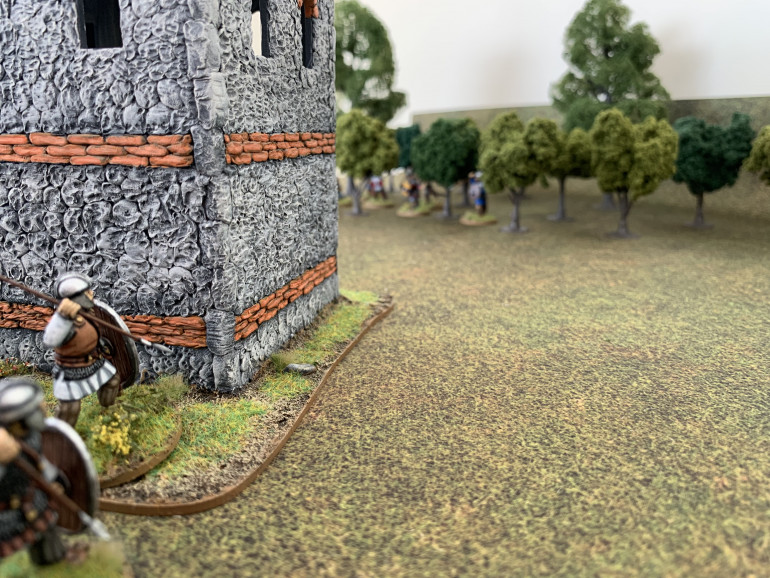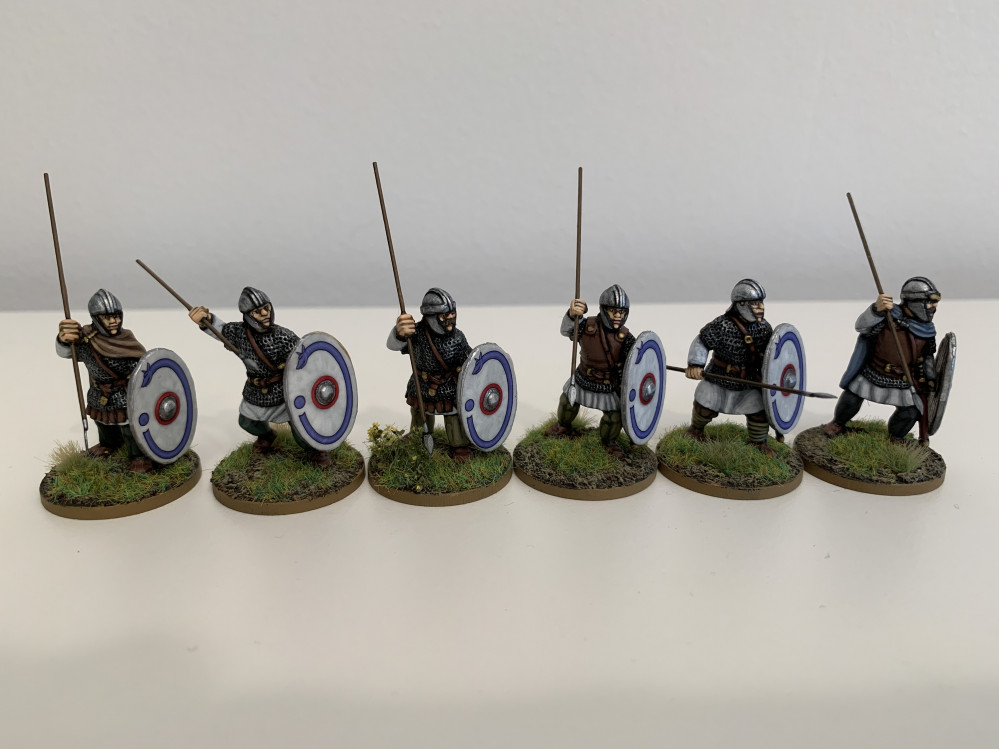
Romano-British for Dux Britanniarum
Recommendations: 1546
About the Project
This was a project started during lockdown to build a Romano-British war band for Dux Britanniarum by Too Fat Lardies. It's stalled of late, so my hope is that by documenting progress on this project I'll be incentivised to finish it.
Related Company: Too Fat Lardies
Related Genre: Historical
This Project is Active
Battle Report - Raid on a Border Tower - Assessment
It’s been a few months since I played this game and so I’ve written this battle report on the basis of my notes and the pictures I took at the time. However, I have to say that I thoroughly enjoyed it back in November and found myself reliving the excitement as I was writing.
There were four pivotal moments in the game. The first was Ceawlin’s devastating charge which eliminated two-thirds of Peredur’s escort in turn two. At that point Garcianus and Urien had barely got the rest of the British force moving and it seemed unlikely they would be able to recover the situation.
However, a series of good move rolls and timely activations meant that Garcianus and Peredur were able to meet in the centre of the table and see off the attack by Berthun the Devil in turn four. I had expected Garcianus’ attack on Saebert’s force in turn five to be more devastating than it actually was. However, as it turned out, the effect of a Carpe Diem card and all the following cards was only enough to offset the effect of casualties, shock and superior forces on the Saxon side. That said, if Garcianus had not made that intervention when he did, the Saxons may have been able to bring superior forces to bear later in the game.
As it was, the sacrifice of the warriors and Comanipulares meant that the stage was set for the Levy to come up and put the depleted remnants of Saebert’s command to flight. Things might have gone differently if Ceawlin had managed to make a better move roll and join the fray, but as it was, Urien Cadwallader and his band of raw amateurs managed to time a charge at exactly the right moment to bring Saxon Morale to zero.
I learnt a lot from this game, but three things stand out:
- Terrain matters. Intervening obstacles played a significant role in reducing movement at key moments. Peredur’s force was left hanging in front of a drystone wall, whilst a hedge kept Ceawlin from joining the last fight with the Levy. Obstacles also forced groups into smaller gaps, reducing the number of men they could commit to the fight.
- Keep rallying off the shock. Having nobles remove shock was crucial to keeping groups in the fight. The British did this more than the Saxons and it showed in the way they were able to keep the depleted warriors and Comanipulares fighting down to the last man. In contrast, the Saxons had fewer opportunities to rally off shock which left them vulnerable to a counter-attack.
- Barbarians don’t always need to charge. I was probably over aggressive with the Saxons, in part driven by the need to try and capture Peredur before he could be supported by the rest of the British force. As such, formations attacked piecemeal, with never more than two groups brought to bear at one time. I might have been better off taking a bit of time to dress the ranks and create a more organised attack of three or more groups, thereby creating a better chance of punching a hole in the British line. Such an approach would also have given the Saxon nobles more of an opportunity to rally off shock before it became an issue.
Overall, I felt it was a pretty good simulation of Dark Ages warfare, with the role of the nobles critical to the execution of attacks. The fact that a well organised band of Levy could see off a group of Hearthguard, but only after the latter had been suitably worn down, also felt like a realistic result and showed that even the weakest troops have a role to play in the warband. Next time I shall try to find a more fully-engaged opponent as I think solo play may accentuate my instinctive bias to the underdog British. I shall have to get to work on some new terrain such as a church or town gates in order to play out some of the other raid scenarios in the rulebook. After all, Ceawlin needs to raise some money fast!
Battle Report - Raid on a Border Tower - Campaign Housekeeping
Dux Britanniarum is meant to be played as part of an overall campaign. I’m not sure when I’ll be able to play again, but I thought it would be worthwhile going through the post-game sequence to see how things would play out.
During this sequence, both sides tot up points depending upon how well they’ve done in the game. The difference in points totals determines the impact of winning or losing. In this game, the British succeeded in rescuing Peredur, which gave them 2 points. They also killed 13 Saxons, which netted a further 2 points. They had also retained an ability card which allowed them to pursue their defeated enemies, giving an extra 1 point. However, they lost 15 men killed, which reduced their total by 2. So overall, the British score was 3 points.
The Saxons killed 15 British, netting them 2 points. However, at 13 killed, their losses were almost the same, not something that will enhance Ceawlin’s reputation. As such, 2 points are deducted to reduce the Saxon total to Zero.
As a result, the difference between the scores is 3 points in favour of Garcianus. He gains a Thief’s Horde in plunder and will recover his losses in one month. Ceawlin gains no loot, and will recover eight of his lost men in one month, should he wish to take the field again with a reduced force. If he wishes to wait until he is back to full strength before raiding Garcianus’ lands again, he will have to wait two months, which might lose too much of the precious campaigning season. Ceawlin will have to choose.
Battle Report - Raid on a Border Tower - Turn Seven
Once again, Urien Cadwallader saw a chance for glory. The wounded Saebert and his 3 remaining Hearthguard were shocked and battered and made a tempting target. Their level of shock was dangerously high an if he could put them to flight it would bring the Saxon Force Morale to zero and the whole barbarian host might flee.
Rallying his men for a final effort, Urien and the Levy charged the Hearthguard. Only two Levy groups could be brought into the fray and 8 British dice were rolled against the Saxons’ 4. This was a bloody melee in which seasoned killers fought a last ditch stand against farmers and townsfolk. The Levy made 5 hits to the Hearthguards’ 4. One member of the Levy fell, but the sheer ferocity of their attack was too much for the already demoralised Hearthguard. How could they be defeated by farmers and clerks? 4 points of shock went onto the Hearthguard bringing their total to more than double their remaining numbers. They “lost their amphora” and fled. Saxon Force Morale fell of Zero and Garcianus and his Britons claimed the field of victory!
Battle Report - Raid on a Border Tower - Turn Six
At this point it was clear that the game could go either way with both sides on a Force Morale score of 4. On the British side both groups of Warriors had been wiped out and the Comanipulares were down to two men. However, the Levy were still at full strength and had established themselves in shieldwall with all of the British nobles close by.
On the Saxon side, one group of warriors had broken and fled, but the remaining groups were still operational, although with casualties and accumulated shock. These groups were working in two formations each consisting of a group of warriors and hearthguard. Saebert commanded the formation nearest the British Levy and Ceawlin would need to move his troops up alongside them in order to bring his full force to bear. However, he would need to do this quickly if he was to stand any chance of completing the original objective of capturing Peredur Constantine without taking further damage to his force’s morale.
The turn started with the British Missiles failing to repeat their success of last turn and all shots missing their target. Ceawlin then tried to bring his formation alongside Saebert’s but to do so they needed to negotiate a hedge surrounding a field alongside the road. The boughs of the hedge were thick and stout whilst its thorns and briars tore at the men’s clothing. As a result, Ceawlin’s men managed a mere 2 inches of movement and barely cleared the obstacle.
The next leader to activate was Peredur Constantine. There was no point in the battle-scarred Comanipulares remaining between the Levy and the Saxons, so he ordered them to move out to the right of the Levy and removed a point of shock.
Then came the turn of Urien Cadwallader. Weighing his options the British noble decided there was no merit in standing to receive the Saxon charge and ordered his men to charge the Saxon hearthguard and warriors led by Saebert the Old. Despite their inexperience, the Levy performed admirably, advancing in shieldwall a full 5 inches, one short of their maximum. This manoeuvre also brought them alongside the remaining Comanipulares, allowing the elites to lend their support.
The sheer weight of numbers provided by the Levy meant the British rolled a massive 25 dice to the Saxon’s 9. The Levy scored 10 hits and the Saxons only 3, but again, the superior quality of the Saxons showed. Despite the disparity in numbers, the British could only kill 2 Saxons, whilst the Saxons claimed the life of another of the Comanipulares, reducing them to 2 men.
Both lines descended into a frenzy of hacking and stabbing as a second round of combat was fought. But this time, the British made their numbers tell. 24 dice resulted in 14 hits and 4 kills on the Saxons. Despite the Saxons making brave use of their 9 dice to cause 2 kills, the determination of the British citizenry to defend their lands proved too much for them. Saebert the Old staggered back wounded, as he watched the group of Warriors under his command wiped out by the enraged Levy. He retreated a short distance with the three surviving Hearthguard under his command and Saxon Force Morale fell to 1. Would Ceawlin arrive in time to save Saebert who was left hanging in front of the British line?
Battle Report - Raid on a Border Tower - Turn Five
Turn five began with Saebert the Old moving his combined formation of Hearthguard and Warriors forward towards Garcianus and the remaining Comanipulares and Warriors. The Saxon Missiles also moved forward, shooting at the British missiles but missing. Peredur Constantine was then activated and used is two command initiatives to remove a point of shock from each of the Comanipulares and Warriors. Over towards the farm, Berhthun the Devil detached himself from the fleeing group and moved to return to the fray. Behind Saebert, Ceawlin collected the group of Saxon warriors who had fallen back from the earlier fight with Garcianus and combined them with his other group of Hearthguard.
This looked to be a turn of consolidation on the Saxon side. They had received a check in the last turn and needed to redress their ranks and rally their troops. But Garcianus had other ideas. Sitting within the British abilities deck was a Carpe Diem card, a powerful ability that would allow a noble to play multiple cards in a single turn. Garcianus saw an opportunity to strike at the Saxons whilst they were still disordered.
Using his first two command initiatives, Garcianus removed a further point of shock from each of the Comanipulares and Warriors. He then used his last command initiative to play Carpe Diem and unleash a run of cards. Audicia gave him a further command initiative which was used to charge Saebert’s formation. Strong Arm inflicted shock on the Saxons, and Hero of the Age allowed him to double his number of attack dice. Usually, this would increase his dice from 3 to 6, but because of Audicia, his command initiative total was 4, meaning that he would contribute 8 dice to the coming combat.
Despite all of this, the continuing impact of casualties and shock meant that the British advantage was not quite as pronounced as it might at first seem. They rolled 19 dice to the Saxons’ 14. Moreover, the Saxon blades were more deadly, making 9 hits that resulted in 3 kills, whilst the British could only manage 7 hits and 2 kills. The result was that the last of Peredur’s warriors was wiped out and British Force Morale fell from 5 to 4.
Both sides were still in the fight however, and a second round was fought immediately. This time the British rolled 16 dice to the Saxon’s 12. The Saxons continued to show their quality. Despite only making 2 hits to the British 7, the result was the same for both sides: 1 dead and 1 point of shock.
Despite the bloodshed, neither side had gained an advantage and a third round of combat commenced. 14 dice were rolled by the British and 11 for the Saxon. This resulted in 6 hits for the British and 9 for the Saxons but neither side made any kills. The amount of shock was greatest on the British Comanipulares and, down to three men, they were obliged to withdraw. The Saxons were unable to follow up.
The retreat of the Companipulares had brought them into direct contact with Urien Cadwallader and his Levy. This allowed Urien to rally two shock off the battered Companipulares. The turn then ended in bizarre fashion when the British Missiles managed to kill one of the Saxon Hearthguard accompanying Ceawlin.
Battle Report - Raid on a Border Tower - Turn Four
The British Missiles came out of the deck first. They launched a volley against Berhthun’s men and although they hit, it had no effect. Next up was Saebert the Old who formed a group of Hearthguard and a group of Warriors into a single formation and then moved it forward. Despite rolling a respectable 10 inches of movement, this still wasn’t enough to bring them within reach of the British. The Saxon missiles also moved 10 inches. Peredur was activated next and moved his warriors into contact with the Comanipulares and then formed them into a single formation to face the Saxons.
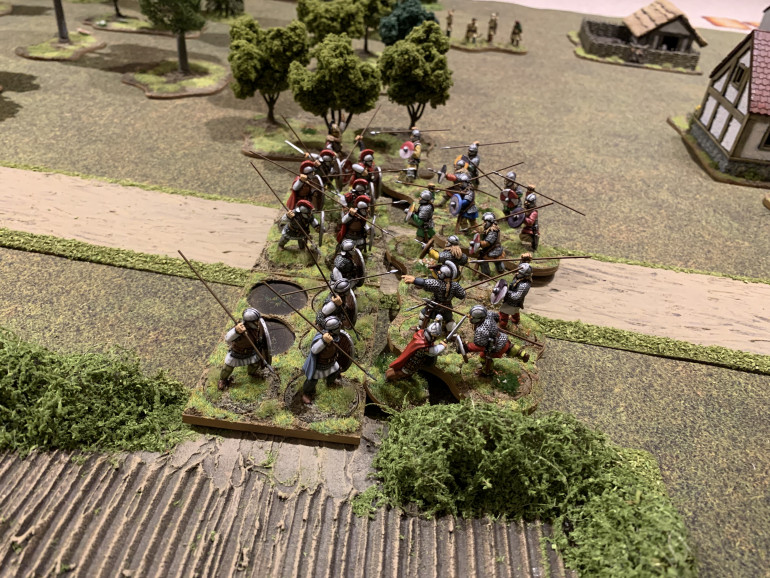 Berhthun the Devil and his men charge the formation led by Garcianus and Peredur. Note the British Missiles skirmishing in the background
Berhthun the Devil and his men charge the formation led by Garcianus and Peredur. Note the British Missiles skirmishing in the backgroundNow came Berhthun the Devil’s chance for glory. Playing the Aggressive card, he led his two groups of Warriors against Garcianus and Peredur’s formation. Alas, it was a rash move for the Saxon. The presence of Garcianus and his champion meant the British rolled 18 dice to the Saxon’s 14. Despite this imbalance, both sides scored 8 hits, but again, the superior training of elites versus warriors showed, except this time it was to the British advantage. The Saxons suffered 3 dead warriors and 3 shock, whilst the British lost a warrior, with the warriors taking 2 shock and the Comanipulares 3. The result was that one of the groups of Saxon warriors fell back 3 inches.
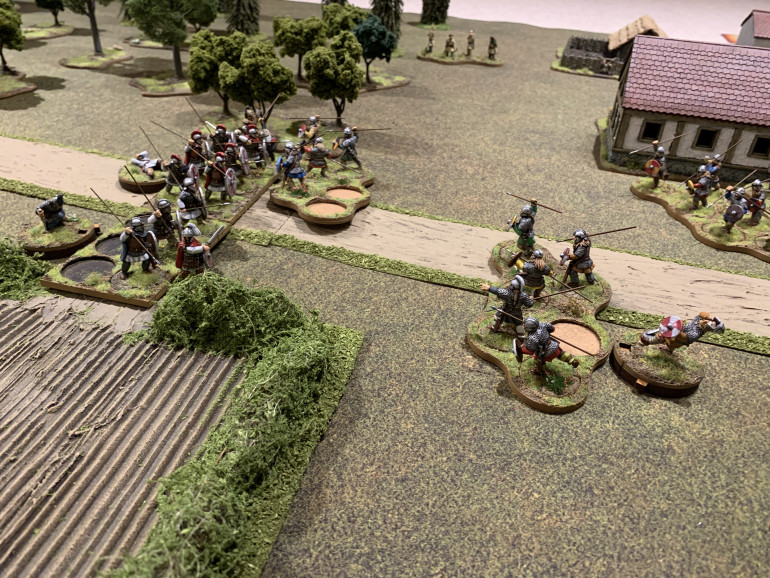 The Saxons come off worse and one group is forced to withdraw, leaving their companions to face the British alone
The Saxons come off worse and one group is forced to withdraw, leaving their companions to face the British aloneThe other group was still in combat however, so a second round was fought. But this time, the effect of the Aggressive card no longer applied, so 6 Saxon dice were rolled against the British 17. There was no cause for complacency on the part of the British however, as those 6 Saxon dice resulted in 2 dead Companipulares. In reply, the British could only kill a paltry 3 Saxon warriors. That said, those casualties, plus the combined shock were enough to break the group of Saxons who had stayed in combat. They ran, taking Berhthun with them. This defeat filled the Saxon onlookers with dismay and Force Morale fell a massive 3 points from 7 to 4.
Next up was Ceawlin who used his command initiatives to move his group and Saebert’s forward (again an illegal move as Saebert had already activated his group in the turn, but this was missed). Garcianus’ card came up next. Viewing the battered state of his men he did not relish a contest with Ceawlin, Cenfus, Saebert and the combined Saxon elites at this stage. Using a newly drawn Bounding Leap card, he ordered his and Peredur’s formation back a massive 16 inches, taking them out of the immediate range of a Saxon charge. They still could not yet count on the support of the Levy however, as despite Urien’s urging, the inexperienced farmers and townsfolk struggled to advance in shieldwall, shuffling forward a reluctant 4 inches.
Battle Report - Raid on a Border Tower - Turn Three
By this stage, Garcianus could see Peredur and his men running down the road, the remnants of the broken group following on their heels. It was time for Garcianus to use his three command initiatives to assert some control over the rapidly deteriorating British position. Using his first command initiative, Garcianus put the Levy into a single formation for Urien to command. He then attached himself to his Comanipulares and ordered them down the road towards Peredur and his remaining band. Although they didn’t quite make contact, Peredur’s warriors were now within Garcianus’ command range, allowing him to use his final command initiative to remove a point of shock from them.
The next card out of the activation deck was the British Missiles who finally emerged from the edge of the wood to shoot at the Saxon groups commanded by Berhthun the Devil, but to no effect. The British run of luck with activations continued however, with Peredur out of the deck next. He used his command initiatives to move his remaining warriors closer to the Comanipulares. Although they were still not quite in contact there was a good possibility that they would be able to form a single formation next turn. These troops would have to hold the line until the Levy could come up in support. The next activation was Urien Cadwalladr who moved his Levy formation down the road towards Garcianus and Peredur and then ordered them to form shieldwall in preparation for the combat that was sure to come. (I think this last move by Urien may have been illegal as the Levy had already been activated when Garcianus put them in formation, but this was missed in the heat of the action.)
All of the British cards had been activated first, a run of luck that had allowed them to stabilise the situation without Saxon interference. However, the Saxons would now be able to react for the rest of the turn. Unfortunately for them, none of their formations could match the speed of the British movement. Berhthun’s group of warriors were closest, but they moved in desultory fashion towards the waiting British. Ceawlin, Saebert and the Saxon Missiles all did likewise, the Saxon force all converging on Garcianus and his men. The situation for the British was perilous but not hopeless. In addition to the 6 elites, 4 warriors, and his own prowess in battle, Garcianus could count on both Peredur and his own champion, Gwallawc Gwerthefyr to aid him in the fight.
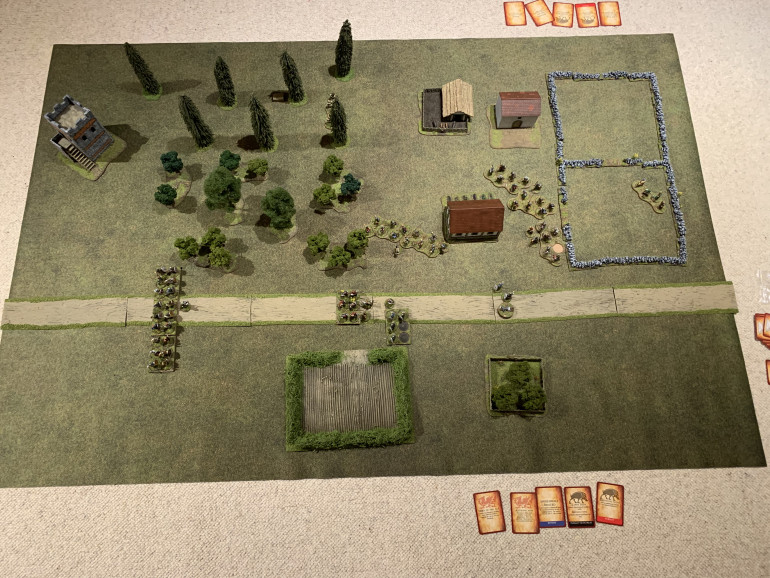 An overview of the situation at the end of Turn Three. Peredur and Garcianus are almost in contact in the centre by the field. Urien and the Levy are advancing behind them. Berhthun is close to charging Garcianus and Peredur, whilst the remainder of the Saxon force struggle to keep up. The British Missiles lurk in the forest behind the bottom pine tree on the right
An overview of the situation at the end of Turn Three. Peredur and Garcianus are almost in contact in the centre by the field. Urien and the Levy are advancing behind them. Berhthun is close to charging Garcianus and Peredur, whilst the remainder of the Saxon force struggle to keep up. The British Missiles lurk in the forest behind the bottom pine tree on the rightBattle Report - Raid on a Border Tower - Turn Two
The activation deck was shuffled and Saebert the Old’s card came up first. He used both his command initiatives to order one group of Hearthgaurd and another of newly arrived warriors over a drystone wall to towards the left flank of Peredur’s warriors. Garcianus came up next and continued his efforts to get the Comanipulares and Levy moving in an organised fashion down the road. The British missiles continued their slog through the woods with a slowness that did no credit to their status as light troops.
The next card to emerge with Ceawlin who found himself facing Peredur’s shieldwall with a single group of his Hearthguard. There was really only one option that an aspiring Saxon Warlord could take in that situation and Ceawlin ordered a charge. This was not quite as suicidal as it sounds. Although the British had more men, Ceawlin’s Hearthguard were elites compared to Peredur’s warriors, meaning they added extra dice to their attack. In addition, Ceawlin would add further dice to the Saxon total as would his accompanying champion, Cenfus. This put the number of Saxon dice slightly higher than the British.
However, Peredur had a ruse to play. Not wanting to engage in combat just yet, he played the Bounding Leap card to have his men withdraw before Ceawlin’s charge commenced. This they duly did, but again, the drystone wall impeded their progress. Had they put enough distance between themselves and Ceawlin?
Unfortunately, it wasn’t enough. Ceawlin and his Hearthguard smashed into the shieldwall. The dice were rolled and each side scored 7 hits. However, the Saxon strikes were far more effective. Despite the shieldwall allowing the British to ignore the first casualty on each group, five British warriors fell dead at the cost of one of the Saxon Hearthguard. The British fell back with one group reduced to three men and the other to four. The British woes were not over yet however, as the Saxon missiles opened up. Another British warrior fell dead reducing one group from three men to two. That group had also taken significant shock. This now massively exceeded the remaining number of men, meaning that the group was broken. Beyond fleeing for the British table edge they would play no further part in the game. In total, the last two Saxon actions had reduced Peredur’s force by two thirds! The broken group of warriors brought British Force Morale down by two points to 5.
Fortunately for Peredur, his card came up next, giving him an opportunity to extract himself from this deadly situation. Gathering his four remaining men around him, he ordered them to run a swift 13 inches to the road at the price of one point of shock. He wasn’t out of the woods yet though. Whilst Urien Cadwalldr continued to try to get the Levy to move down the road, Berthun the Devil started moving two groups of Saxon warriors around the side of the farm, hoping to head off Peredur before he could reach safety.
Battle Report - Raid on a Border Tower - Turn One
In Dux Britanniarum, nobles and forces are activated when their card is drawn from a deck made up of a card for each noble and any missile troops that may be included in the force. Each side is also given a separate set of cards with special abilities that a noble may spend a command initiative to play.
Peredur Constantine’s card was first out of the deck and seeing Ceawlin’s elite forces coming towards him he decided to have his men form a shieldwall and then try and move towards the road leading to the border tower. This was a mistake on my part as troops in shieldwall find it harder to negotiate obstacles. True enough, they only just managed to make it over the drystone wall and both groups took a point of shock. I should have made the movement roll first and then formed the shieldwall, or simply formed shieldwall behind the drystone wall to get a defensive bonus. As it was, I ended up making only marginal progress towards the road and forming a shieldwall out in the open. Still, these initial games are all about learning.
Ceawlin however was faced with a different dilemma in that the gap between the farm buildings was only wide enough to admit one group at a time. As he wanted both groups to attack Peredur’s force together, he sent them both around opposite sides of the barn, keeping one group under his command and the other under Saebert the Old.
In the rest of the turn Garcianus and Urien struggled to get the Comanipulares and the Levy moving, whilst Berhthun the Devil brought on two groups of warriors on the Saxon board edge. Meanwhile the Saxon bowmen sent an ineffective volley against Peredur’s men, whilst the British missile troops made slow progress through the forest hoping to emerge on the other side and harass the Saxon right flank.
Battle Report - Raid on a Border Tower - Introduction
This was a semi-solo battle played out last November using one of the Raid scenarios in the Dux Britanniarum rulebook. I had met with @Avernos at Salute and said that I would use my newly purchased terrain from Lost Valley to make good on my promise to produce a battle report.
I played both sides with Son No. 1 taking control of the Saxons when he was interested. (I later learnt that he much prefers Frostgrave when it comes to tabletop gaming, but maybe an appreciation for historical gaming will come later.) This particular scenario was the Raid on a Border Tower. Technically, you should roll for which scenario will be played, but regular followers of this project will know that I spent rather a long time putting a greenstuff wall on an MDF tower last year and I was keen to use it.
The scenario begins with a British Noble returning from patrol accompanied by two groups of six warriors. The objective of the Saxon player is to capture the noble by defeating his escort and overwhelming him in close combat. The game is played lengthways across a 6×4 table, with the noble and his escort entering at one of the short board edges and the Saxons entering from one of the long edges. The remainder of the British force are stationed around a border tower at the other side of the board. They will need to get to the returning noble and his force before they are crushed by the might of the Saxon warband.
The photo above shows the setup at the beginning of play. Garcianus and his Comanipulares are by the border tower, along with Urien Cadwallder and the Levy. Peredur Constantine and his patrol are resting by the drystone wall of a livestock enclosure when they are shocked to see Ceawlin and his two groups of elite Hearthguard appear on the other side of the farm. Both sides start with a Force Morale score of 7.
Casualty bases/Shock markers
Casualties are removed in Dux Britanniarum, but like a lot of Too Fat Lardies games there is a system of shock to represent the attrition and fatigue of battle. You can represent shock with counters, but I wanted something that would be more integrated into the tabletop.
To address this I bought some dial counters from Charlie Foxtrot to keep track of the level of shock and some casualty figures from Gripping Beast to represent the overall weariness of a unit.
My advice is to attach the miniature to the top base of the counter (the one with the square hole to see the numbers through) and paint and base everything on that first.
Attach the pivot to the bottom base using undiluted PVA. Use the bevel as a means of aligning the pivot to ensure it is central to the bottom base. Carefully lift off the bevel once the pivot is aligned as you don’t want it to be accidentally glued in place!
Once the pivot and bottom base have dried, place the bevel back over the pivot being sure to keep the numbered side facing upwards. Place undiluted PVA on the upper face of the pivot and then place the top base on top. Use your fingers to ensure a good alignment with the bottom base and bevel.
Be sure to keep the PVA away from the edge of the pivot when gluing down the top base. You don’t want to push any excess PVA onto the bevel, as that could glue it in place and prevent it moving freely.
Also, ensure you give plenty of drying time. Resist the urge to touch the completed assembly and try it out as it will just pull apart or become misaligned if you use it before it’s ready.
Complete Early Saxon warband
Saxon Lord - Ceawlin
Do you ever get the feeling that a miniature just doesn’t want to be painted? That you can’t get the colour combination correct or you just aren’t satisfied with what you’re doing? We’ll Ceawlin was like that and he took me far longer than he should have done.
By way of background, Ceawlin is my Saxon Lord and the last figure in this force. He is 29 and has a Man Mountain physique meaning he will get a bonus for feats of strength like breaking down a door. He also has the Lustful attribute meaning he covets the women of others, so suffers a penalty when testing the loyalty of his men (possibly he has been led astray by Saebert who had the same attribute). He is a Wodenborn aristocrat, born in Britain the son of a foederati in Roman service. He has a Tribune’s Tribute in wealth.
Ceawlin is Footsore’s Early Saxon Chief figure. I wanted to give him some finery, so started off by doing a light blue tunic with yellow trim. The blue was a base coat of 50/50 VMC Grey Blue and VMC Prussian Blue which was then highlighted up by adding White. The yellow trim was a base of VMC Beige Brown, the a 50/50 mix of Beige Brown and Yellow Ochre and then a final highlight of Yellow Ochre. So far so good.
I then gave him a green cloak with red trim and this was just too much. My wife then told me that there is an old saying that goes “Red and Green should not be seen, except upon a Fairy Queen.”
Now I fully accept that the OTT project system is a place where you stand a greater chance of spotting a Fairy Queen than you might ordinarily. But this is a historical project and I wasn’t having my Saxon Warlord described in such a way, so the green cloak was hastily painted over in black.
I then went into a bit of hobby funk with Ceawlin and couldn’t summon up the energy to finish him.
The change came when I decided to try the cloak again. This time I decided to go for a brown cloak that was less likely to distract the eye from the blue and yellow tunic. But I wanted to make it a bit finer than the norm. I therefore tried a technique from the Dark Ages edition of the Painting War series of occasional magazines. This involved starting from a base of VMC German Camo Black Brown and then gradually adding Chocolate Brown to the mix in 25% increments. In between each highlight you put in a glaze of 50% of the previous highlight mixed with 50% of the next highlight heavily diluted with water. This went on until you had a highlight of pure Chocolate Brown. This was then mixed with 50% Flat Earth before a final highlight of 100% Flat Earth. Very time consuming, but you get a nice transition between highlights.
The brown cloak was a much better counterpoint to the bright tunic and I started to feel a lot better about Ceawlin. One interesting thing I noticed about this figure is that he wears a fairly long hauberk of scale mail that comes quite a way down the front of his legs. Interestingly, this isn’t sculpted on at all on the rear of the model between the scabbard and the cloak. This seems to have been an oversight on the part of the sculptor as it should be there if it came to the same length at the back. As such, I had some fun painting on the scales (something that would have been harder if he wore chain mail) in the small area where they should appear. You can see my efforts in the Lloyd shot above and I’m quite pleased with them.
As Ceawlin is an aristocrat, I decided to risk giving him a glided helmet. It was a bit of a risk as it could have looked a bit over the top, but I think it’s worked well. I always use VMC Old Gold for this sort of thing as it has a more muted tone than VMC Gold proper.
An LBMS shield transfer completed the figure and Ceawlin is now ready to lead his troops.
I’ve now completed two opposing forces for Dux Britanniarum. I think Ceawlin took so long because I couldn’t quite bring myself to make that final leap to actually finish a project.
I’ll try and post some pictures of the complete Saxon force later this weekend and then maybe actually play a game and do a battle report!
Having said that I couldn’t quite bring myself to finish a project, I should add that I have some extras and some terrain still to bring into the mix. However, I think having two table-ready forces is an important milestone!
Saxon Noble - Berhthun the Devil
This is the second of my two Adeligs or Nobles for my Saxon force. Berhthun is 23 and has a short and wiry physique. Like Saebert he also has an existing reputation as a Devil, so clearly he is not above raiding a church or two. He has the Athlete attribute which gives him certain advantages in withdrawing from combat if he needs to. He is the son of a Peasant.
In view of the short and wiry physique, I chose one of Footsore’s Saxon nobles to represent Berhthun. I thought the darting forward pose suited the type of fighting style someone with that description might adopt.
His gilded helmet is a prominent feature of the miniature and I wanted that to be the focal point and not have brightly coloured clothes drawing away that attention. Berhthun therefore got a black tunic highlighted with an 80%/20% VMC Black/VMC Neutral Grey mix, increasing the Grey by 20% for a top highlight. He also got a grey cloak which was a base coat of VMC Neutral Grey progressively highlighted by adding White. To ensure that it wasn’t completely unrelieved darkness, I gave his cloak a red lining to give a brighter counterpoint to the rest of the miniature.
A Little Big Man Studios shield transfer completed the job.
Saxon Noble - Saebert the Old
This is the first of my two Saxon Nobles or Adeligs, junior leaders that assist my Warlord.
I used the name generator on the Too Fat Lardies blog to roll up the name “Saebert” for this character. Then, using the tables in the Dux Britanniarum rulebook I found that his age was 34, quite an old man by contemporary standards. He has a physique of average build and has an existing reputation. Appropriately enough that reputation is “Old”, so clearly his men think he’s been lucky to last this long as well! Fortunately, this is not one of the reputation descriptions that have an impact on the campaign. However, what does have an impact is Saebert’s roll on the Character Attributes table where he gains the “Lustful” attribute and is described as coveting the women of others. This means that should Saebert ever rise to command the warband, he will have a penalty in gaining the loyalty of his men, although this is probably more of a problem for a Romano-British character than for a Saxon. A roll on the background table shows that Saebert is the son of a peasant, born in a hovel in northern Germany. Fortunately, he is not the Warlord as that roll would reduce his starting wealth.
Saebert is the command figure from Footsore’s Early Saxon Heavy Infantry Command set. He had an open hand which was rather wide and wouldn’t close round my usual wire spears. Instead, I gave him a spare Gripping Beast axe cast from metal which I think looks better. A bit of greenstuff was used to extend the thumb around the axe handle slightly and to embed it in the open hand. I thought about trying to do his eyes, but then decided against it, as in real life you would have to be up very close to see through the vision slits of his closed helm.
Saebert’s fellow Adelig “Berhthun the Devil” is next on the painting desk!
Saxon Champion
Like the Romano-British, the Saxons also get a Champion to accompany their leader. He’s useful for aiding the troops in combat, taking a hit for his boss and engaging in trial by combat with the enemy champion before a battle. A quick roll on the name table tells us this particular psycho goes by the name of Cenfus (pronounced Chen-fuss).
Cenfus is a Gripping Beast sculpt from their Early Saxon Characters set. I’d not really painted someone displaying so much flesh before but I’m happy with how he turned out. I started with VMC Light Brown as a base, with a 50:50 mix of Light Brown and VMC Sunny Skintone as the first highlight. I then did a final highlight of VMC Sunny Skintone and thought I was done. I then received feedback from my wife (always my harshest critic) that he looked very orange and was he meant to be a Dark Ages version of Donald Trump. Stung by this I then went for a further highlight of VMC Flat Flesh in order to tone down the perma-tanned look.
I think I mentioned in an earlier post that I was a bit uncertain about whether or not to cover up the severed head and disguise it as some form of moss covered hillock. In the end I decided to keep it. I have to say that there wasn’t really much to work with in painting terms and I’m not sure it helps the miniature. It’s essentially part of the base and given that faces and bases are what people look at the most, it does draw attention to itself. Unfortunately, it’s then not particularly obvious what it is unless you look closely and then it’s a distraction from the rest of the figure, which is a pity as I think the rest of it is great. Perhaps I could have painted the severed head better, but I rather feel that with this miniature less would have been more.
However, this is really a minor gripe and overall I’m very pleased with how he’s turned out. I’m perilously close to finishing the warband now with just the two nobles and the warlord to come.
Hearthguard
I finished the two groups of elite Hearthguard this week.
Each group consists of three Footsore and three Gripping Beast. The Footsore are a combination of their Early Saxon Thanes and Heavy Infantry command group, whilst the Gripping Beast are the Gedriht from their Early Saxon range. The shields were done with LBMS transfers. If you know the figures you’ll be able to tell the difference, but the two ranges are a good size match and gel well when grouped together.
All of the Gripping Beast models came with empty scabbards, implying that they should be holding their swords. They are all open handed figures but come with a variety of white metal swords and axes. It seemed odd to give a figure an axe if he had an empty scabbard, so I did try to see if I could fill a scabbard but chopping off the hilt of the sword and gluing it into place, but the fit was impossible to get. Instead I embedded the now broken sword into the sabot base as a weapon shattered in combat!
I particularly enjoyed painting the figure in the wolfskin cloak. This was done with a mix of VMC Olive Drab and VMC Ivory, steadily lightening the mix with Ivory before a final highlight of White.
These two were particularly striking figures. The one on the left is the standard bearer that comes with Footsore’s Early Saxon Chieftain. But I’ve given him a Gripping Beast axe to make him stand out. The one on the right I just like because of the pose. I think of these two as the leaders of the two groups, even though that has no impact on the game. But they will probably be always the last to fall!
Next up are the two Nobles, the Champion and the Lord.
Slowly making progress
I finished the third group of Saxon warriors and the group of four archers this weekend. Slowly making progress with the two groups of elite hearthguard next on the painting table.
Saxon warriors - Groups 1 and 2
“…a fire heaped up by the impious easterners spread from sea to sea. It devastated town and country round about, and, once it was alight, it did not die down until it had burned almost the whole of the island and was licking the western ocean with its red and savage tongue…”
Gildas, De Excidio
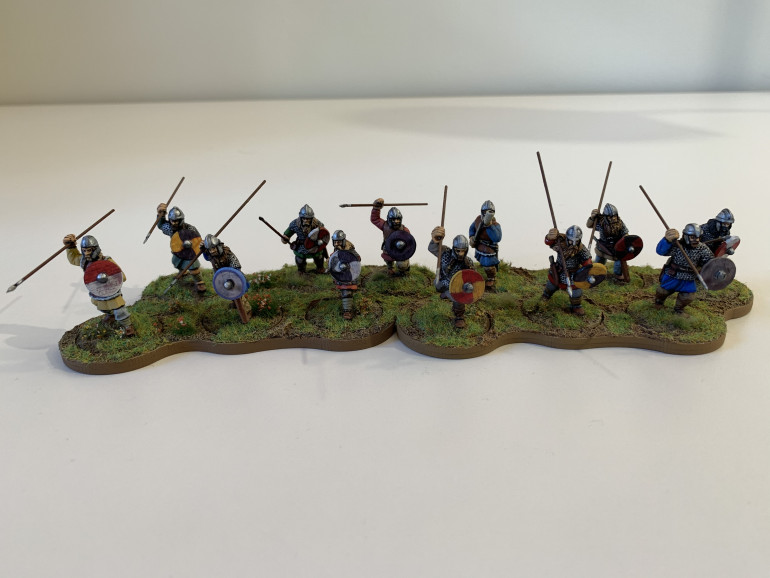 Saxon warriors. In two of them I managed to get paint either on or behind the shield transfer, but I think it passes nicely as battlefield muck!
Saxon warriors. In two of them I managed to get paint either on or behind the shield transfer, but I think it passes nicely as battlefield muck!With a suitable introduction from Gildas, here are my first two groups of Saxon warriors. I was a bit hesitant in starting these, spending too much time agonising over colour choices and how I would ensure that they didn’t look too uniform. In the end, the solution came when I decided that it was more important to get started.
As most of each figure is covered in mail, I did that first, drybrushing with VMC Gunmetal Grey followed by a drybrush of VMC Silver. Once that was done, I did the faces.
Next came the tunics and it was here that I decided to stop worrying about colour combinations and mixes and see it more as an opportunity to try something new. So I resorted to the very simple expedient of grabbing any colour I hadn’t used before and putting it down as the base coat. I then mixed it with varying amounts of either White or Iraqi Sand to fade and mute the colour in the first and second highlight.
It helped that I had recently read in a book on the Vikings that their clothes were very brightly coloured and not the dull browns and blacks of popular depiction. I took that as carte blanche to choose whatever colour I pleased and go with it for these Saxons who would have come from a similar culture. The LBMS shield transfers were also brightly coloured which helped validate my decision. In the end it was very liberating and I was able to bash these out relatively quickly. I think I’ll take a similar approach with anything prior to the late Seventeenth Century in future.










































